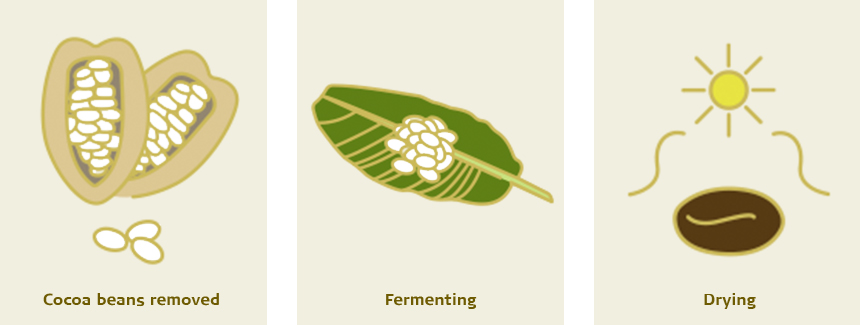Manufacturing chocolate – from the cocoa bean to the bar
Manufacturing chocolate is a challenging process. It takes a long time to get from the bitter-tasting cocoa bean to the high-quality, delicately smooth chocolate. Each step of the manufacturing process has a significant influence on quality.
Cocoa farming, fermenting & drying
The cocoa tree thrives in an area of around 20 degrees north and south of the equator and most enjoys temperatures between 25 and 28 degree Celsius. It blooms and produces fruits all year round. The ripe and healthy cocoa fruits are plucked and cut. The beans are then scraped out and poured into wooden fermentation crates, which are kept away from direct sunlight.
The fermentation process triggers the development of flavours. The cocoa beans are turned regularly during the fermentation process, which can last from two to eight days depending on the bean variety. The cocoa beans must be dried after fermentation, as the fermented beans still contain 60% moisture. The natural method of drying the beans in the sun is the best. The beans are spread out on tables and covered when it rains. The drying process lasts up to eight days. The cocoa beans are shipped to Europe. The beans need enough air during the journey to prevent them being ruined by post-fermentation or even mould formation.
Roasting, cracking & grinding
The flavour precursors from fermentation continue to develop during the roasting process. The beans are roasted carefully and according to their size. The shell is then cracked and separated from the core of the cocoa bean – the so-called nib. The nibs are carefully ground in the stone mill without the flavours getting lost. The frictional heat causes the cocoa butter to liquefy and create the liquid cocoa mass.
Mixing & rolling
The frictional heat causes the cocoa butter to liquefy and create the liquid cocoa mass. The chocolate process starts in the mixer. Cocoa butter, sugar and, depending on the recipe, milk powder and further ingredients are mixed with the cocoa mass. The resulting basic chocolate mass is crushed in the rolling mill. The mass must be very finely rolled since particles as small as 0.025 mm can be experienced as a sandy sensation by the tongue.
Conching, tempering & pouring
The conching process is the actual key element of the refinement process. In the conching machine – also known as a conche – the chocolate mass is heated, agitated and aerated. The typical chocolate flavours form while moisture and undesired volatile flavours can escape. Depending on the recipe, the conching process can last from a few hours to more than 70 hours.
The finished chocolate is adjusted to precisely the right temperature in the tempering device. This ensures that evenly sized crystals form when the cocoa butter later sets in the mould and the chocolate forms a fine glaze and nice shine. The liquid, tempered chocolate is then poured into the mould, cooled, tapped out and packaged.
Overview of the chocolate production process:
Grand Cru chocolate – exquisite indulgence
Discover the secret of the exclusive Läckerli Huus “Grand Cru” creations.
The finest chocolate dreams from Läckerli Huus
Everything you need to know about our chocolate creations.






